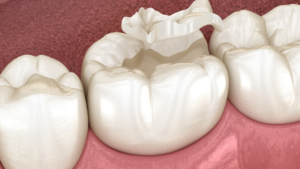Repairing teeth in Isle of Man
Teeth repairing treatment
At our Isle of Man practices, we are experts in repairing broken or chipped teeth. Using the latest dental technology we can help you achieve a beautiful, natural smile.

If you’re beginning to notice decay, the next step to cover the damage and restore your tooth to its natural looking state is an onlay or inlay.

What are inlays & onlays
Dental inlays and onlays are restorations used to repair rear teeth with mild to moderate decay or cracked and fractured teeth that are not sufficiently damaged to need a crown.
Ideal candidates for inlay or onlay work typically have too much damage or decay in the tooth structure to be successfully treated using a filling, but have sufficient healthy tooth remaining to avoid the need for a crown. This allows the dentist to conserve more of the patient’s original tooth structure.
What are the benefits?
In comparison to other metal fillings, there are multiple benefits to Inlays and Onlays:
- Inlays and onlays are durable — they’re made from tough, hard-wearing materials which last up to 30 years.
- They help to strengthen teeth by up to 75 percent, unlike traditional metal fillings which can actually reduce the strength of the teeth by up to 50 percent.
- Inlays and onlays prolong tooth life and prevent the need for more dental treatment in the future.
What are onlays and inlays made from?
Like fillings, inlays and onlays are usually made from porcelain or composite resin to blend naturally with the rest of your teeth and provide lasting strength and reinforcement to your otherwise damaged tooth. It is possible to get gold and amalgam inlays and onlays, however composite resin and porcelain choices make for a solution that is hardly noticeable.
How long does an onlay or inlay take to fit?
Treatments will take two appointments as the carefully moulded part to replace your tooth needs to be crafted in a dental laboratory. On your first visit, your dentist will take a mould of the tooth, which will be used to create the inlay or onlay. Your finished inlay or onlay will then be carefully fitted during your second appointment.
Do I need an inlay or an onlay?
Larger cavities are best treated with inlays and onlays, as fillings simply won’t manage the damage. Inlays are very similar to fillings in that they close up a gap. An inlay sits inside your tooth, while an onlay is fitted to the outside of it and is usually used to build up any area of tooth damage or if your tooth has fractured. It is often the back teeth that require this kind of attention, as the surfaces of the ‘chewing’ teeth are particularly vulnerable to developing cavities.
You may also have an amalgam (silver) filling that you would like replaced with a more natural coloured onlay or inlay. Our dentists can remove old fillings, clean out any existing decay and replace unsightly dark patches with a more natural looking treatment.
When your tooth shows signs of decay, your Isle of Man dentist can help to stop it before any further damage is caused.

Dental fillings in Isle of Man
Available at all of our practices, we provide fillings for private and NHS patients dependant on specific needs. Some fillings treatment may only be available privately.
What are fillings?
When your tooth shows signs of decay, your Isle of Man dentist can help to stop it before any further damage is caused. Fillings are applied to small and developing cavities to restore your tooth back to its normal shape and prevent any further decay.
Spot dental decay
Many people still have silver or mercury fillings in their mouths from years past. These fillings are not particularly pleasing to the eye, and we know that by unavoidable design, silver/mercury fillings ultimately result in a weaker tooth structure.
Porcelain inlays and tooth coloured Restorations (onlays) create fillings that are not only beautiful (or unnoticeable) but also add strength to weakened teeth. These restorations are aesthetically pleasing and very strong thanks to new bonding technologies.
What are white fillings?
White fillings are now becoming a popular alternative to amalgam fillings. The new dental materials mean it is much easier to find a perfect match for the shade of a particular tooth. In most cases, it is quite impossible to see that the tooth even has a filling.
In almost every case, where fillings are needed, white or tooth-coloured filling materials will be discussed as an attractive alternative to silver mercury fillings. Modern, state of the art materials manage to combine excellent aesthetics and cosmetic improvement with high flexural and tensile strength, fracture toughness and wear and erosion resistance. Some patients request that all their metal fillings be replaced with tooth-coloured restorations, while others only decide when it is clinically necessary to do a filling.
The Advantages of White Fillings
- Since they bond to the tooth, composite fillings restore most of the original strength of the tooth. Silver weakens the teeth, making them more susceptible to breaking. Since broken teeth are very expensive to restore, composites can save a lot of expense over the long run.
- Composite fillings restore the natural appearance of the tooth.
- Teeth restored with white fillings are less sensitive to hot and cold than teeth restored with amalgam, if correct techniques are used.
- Composites are mercury-free. Mercury in the fillings is viewed by some as being toxic.
- Composites require less removal of tooth structure. Especially with new cavities, the size of the hole made for the filling can be dramatically smaller with composites.
